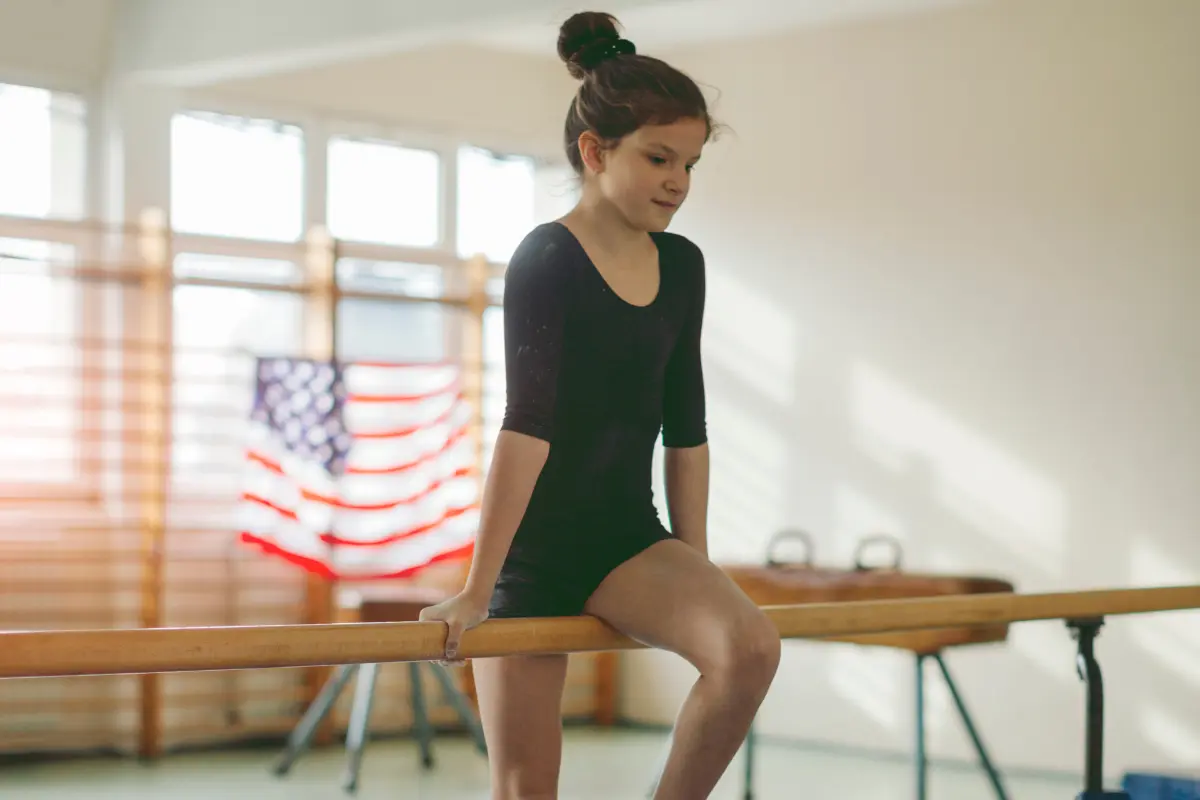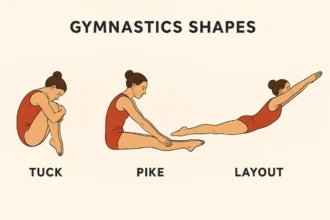In competitive gymnastics, the mill circle is considered a “building block” skill. This movement, performed on uneven bars, involves a circular rotation around the bar with one leg extended and the other bent, and it is typically introduced at the lower competitive levels.
In the United States, the mill circle is a compulsory skill for Level 4 gymnasts, part of the USA Gymnastics (USAG) Junior Olympic program.
Although it is not performed in higher-level routines, its mastery is a prerequisite for advancing to more challenging elements. Coaches use the mill circle to evaluate a gymnast’s readiness for more advanced skills, ensuring that they have the necessary strength and technique.
Mastery of the mill circle helps gymnasts develop essential skills such as:
- Grip Strength: Holding onto the bar securely throughout the circular motion builds the grip strength necessary for more complex skills.
- Body Control and Coordination: Maintaining a tight, controlled body position during the swing is crucial for executing more advanced maneuvers smoothly.
- Spatial Awareness: Understanding how the body moves in space around the bar is vital for transitioning between skills and executing routines with precision.
How to Do a Mill Circle on Uneven Bars?
Here are the key pointers to master this exciting trick:
Starting Position
First and foremost, ensure your legs are tight and your body is aligned. Your shoulders and hips should be as straight as possible to avoid twisting, which can throw off your balance.
Hand Position and Grip
Your hands need to turn backwards on the bar. This might be uncomfortable at first, but it’s essential for maintaining control during the circle.
Imagine reaching out with your front leg as if you’re pulling out a giant oyster shell from the ocean. Keeping this visualization helps maintain the necessary leg extension.
Maintaining Form
As you begin the mill circle, do not drop your front leg too quickly. Maintain a straight chest to avoid collapsing your upper body.
Focus on a spot in front of you to help with balance—this technique is known as “spotting.”
Core Engagement
A crucial part of the mill circle is engaging your core. Keep your stomach tight to prevent arching your back, which can cause you to fall backward.
Think of your body as a straight line from your shoulders to your hips, like sitting in a rocking chair with a straight back.
Leg Position and Movement
At the midpoint of the circle, your legs should be wide open. As you progress, slightly bring your front leg closer to your back leg to gain more control.
This adjustment can make a significant difference in maintaining balance and completing the circle smoothly.
Safety Tips
Safety is paramount. Always turn your hands backwards on the bar. If you feel you won’t complete the circle, turn your hands back around to regain control and prevent a fall.
Practice the movement in parts to get comfortable with the forward motion before attempting the full circle.
Step-by-Step Instructions
- Initiate the Swing:
Kick your back leg up to initiate the forward swing. This leg should be straight and lead the motion. Simultaneously, lean slightly forward and lift your front leg to keep it parallel to the bar.
- Circle Motion:
As your body swings forward, let your back leg guide the movement while your arms remain straight.
Shift your weight around the bar, keeping your body in a straight line. The motion should be smooth and controlled, not jerky.
- Rotation and Leg Position:
During the swing, ensure your leading leg (the back leg that initiated the swing) remains straight and leads the rotation.
Your trailing leg (the front leg) should follow the motion, and both legs should stay close to the bar.
- Complete the Circle:
As you complete the circle, shift your hips slightly to facilitate the motion. Maintain a firm grip on the bar and keep your arms straight to control the swing.
- Finishing the Move:
As you return to the starting position, guide your body back to the initial stance with one leg forward and the other back. Ensure a controlled stop, avoiding any extra swings or movements.
Common Mistakes
- Bent Arms: Keep your arms straight to avoid losing control. Bent arms can lead to incomplete rotations.
- Loose Body Position: Maintain a tight body position throughout to prevent wobbles and ensure a smooth circle.
- Incorrect Hand Shift: Practice the wrist flick to avoid losing momentum and ensure a complete rotation.
How to Teach and Spot the Mill Circle in Gymnastics?
The mill circle, also known as the stride circle, is a fundamental skill in gymnastics, often taught at the beginner level. It is essential for developing coordination, timing, and strength in young gymnasts.
Here’s a detailed guide on how to teach and spot the mill circle effectively:
Safety First
Teaching the mill circle involves risks, such as falling forward and potential arm injuries. To mitigate these dangers, ensure a mat is in place and supervise closely. This is not a skill for unsupervised practice.
- Hand Grip Adjustment: For the mill circle, unlike previous skills, the thumb should wrap around the bar. This grip adjustment is crucial for maintaining control.
Initial Steps
- Learning to Fall: Start by teaching kids how to fall safely. This involves practicing wrist rotations to maintain a grip on the bar. Layla demonstrated the importance of not letting go, which could lead to elbow injuries.
Transitioning to the Bar
- From Underneath to On Top: The next step is moving from beneath the bar to above it, which concludes the mill circle. There are two methods depending on the gymnast’s size and handling ease.
- Method One: For smaller gymnasts, guide them to swing their legs with straight arms and legs, ensuring good posture. Position the bar closer to the upper leg to prevent falling backward.
- Method Two: For larger gymnasts, starting with a knee hook can be easier, though the goal remains to transition to a straight-legged position.
Performing the Mill Circle
- Executing the Mill Circle: With straight legs and elbows, the gymnast should sit on the bar first to build confidence. Ensure the bar stays in the upper leg area, and focus on maintaining straight posture and legs throughout the movement.
Practice and Spotting
- Consistent Practice: The more the gymnast practices, the more comfortable and proficient they become. Pay attention to the straightness of the legs and elbows, as well as the bar’s position.
- Spotting Techniques: Spotting is essential, especially when the gymnast lifts before rotating around the bar. Hold the shoulder for control and the foot to prevent over-rotation.
Advanced Practice
- Building Power: For advanced practice, ensure the gymnast lifts before rotating to build the necessary power for performing the mill circle independently.
Final Tips
Remember always to have a mat under the bar, and never let children attempt the mill circle unsupervised to avoid injuries. With patience and practice, your young gymnasts will master the mill circle.
After completing the mill circle, gymnasts can transition into a front hip circle by leaning forward and rotating around the bar, or into a back hip circle by swinging their legs over the bar and rotating backward.
They can also perform a cast from the front support position, pushing their hips off the bar and lifting their legs horizontally, setting up for other elements like the shoot through or underswing dismount.












